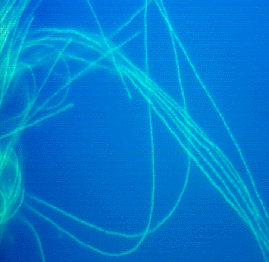Thermobifida fusca
Classification
Higher order taxa
cellular organisms; Bacteria; Actinobacteria; Actinobacteridae; Actinomycetales; Streptosporangineae; Nocardiopsaceae; Thermobifida; fusca
Species
Thermobifida fusca strain YX
Description and significance
Thermobifida fusca, formerly known as Thermomonaspora fusca, is a rod shaped, thermophilic organism found in decaying organic matter and is a major degrader of plant cell wall (1, 2). Its preferred habitat are compost heaps, rotting hay, manure piles, or mushroom growth medium because these are self-heated organic materials that can reach Thermobifida fusca’s growth temperature of 55ºC (2). The genus Thermobifida comprises of 2 members, the other being Thermobifida alba (1). Both members of the genus are acid fast, Gram-positive aerobic organisms (1). It is important to map out the entire genome of this organism because of its biotechnological uses. The organism produces multiple extracellular enzymes including cellulases that are responsible for the decomposition of cellulose and lignocellulose residues, which is important for the breakdown of agricultural and urban wastes (1).
Genome structure
Thermobifida fusca “has a single circular chromosome of 3,642,249 bp predicted to encode 3,110 proteins and 65 RNA species with a coding density of 85%” (4). There are also other enzymes such as glycosyl hydrolases as well as cellulases and xylanases that are necessary for the degradation of plant cell walls (4). T. fusca has a 67.5% G-C content which is expected for an organism that can survive in high temperatures and a wide pH range from 4 to 10 (2).
Cell structure and metabolism
Actinomycetes generally grow as branched aerial hyphae which help the organism in the penetration and degradation of insoluble substrates such as lignocellulose (1). Thermobifida fusca do not have flagella or pili. Their cell wall contains two teichoic acids made of poly(glycerol phosphate) (6). “Cell-wall analysis revealed the presence of meso-diaminopimelic acid, but no other characteristic amino acids or sugars in the murein.” (3) It also has an endospore, which help it to survive in the rough environment for long periods of time (1).
Ecology
Thermobifida fusca is usually in the “presence of abundant plant materials and other bio-polymer substrates of natural origin.” (1) T. fusca contributes to the environment by decomposing organic matter such as rotting hay, compost, manure or urban waste piles. There are also other thermophilic actinomycetes that share its natural habitat (1).
Pathology
The actinobacterium produces spores that can be allergenic in humans and cause a respiratory condition called farmer’s lung disease and mushroom worker’s disease (2). Farmer’s lung disease and mushroom worker’s disease are examples of hypersensitivity pneumonitis, an inflammation of the alveoli within the lungs caused by inhaled organic dusts. These diseases usually develop in agricultural workers who breathe in large amounts of actinomycete spores (1).
Application to Biotechnology
Thermobifida fusca produces multiple extracellular enzymes including cellulases that are responsible for the decomposition of cellulose and lignocellulose residues, which make up the bulk of agricultural and urban wastes (1). T. fusca is important for waste remediation because they can degrade all major plant cell wall polymers except lignin and pectin (2). The cellulose-decomposing capabilities of this organism are of importance in establishing safe biotechnological processes (1). There is also good potential for use in the wood and paper industry (1). Cellulases are being studied for their “thermostability, broad pH range (4-10), and high activity.” (2)
Current Research
1) David B. Wilson has been studying Thermobifida fusca cellulose degrading proteins for 25 years. Six extracellular cellulases and an intracellular beta- glucosidase used by T. fusca for cellulose degradation have been purified and characterized (7). He also “cloned and sequenced the structural genes encoding these enzymes, and helped to determine the 3-dimensional structures of two of the cellulase catalytic domains.” (7)
2) David B. Wilson’s research helped to determine the “mechanism of a novel class of cellulase, family 9 processive endoglucanases” (7). He helped show that there were two types of exocellulases. One type attacked the non-reducing ends of cellulose and the other type attacked the reducing ends (7). Research on the regulation of T. fusca cellulase have shown that “cellobiose is the inducer and that cellulase synthesis is repressed by any good carbon source.” (7)
3) Transcriptional regulation and secretion of cellulases which may facilitate the industrial exploitation of these systems have been researched (4). “T. fusca possesses two protein secretion systems: the sec general secretion system and the twin-arginine translocation system.” (4) The twin-arginine translocation system may mediate the secretion of cellulases (4). “T. fusca has extensive transport systems for import of carbohydrates coupled to transcriptional regulators controlling the expression of the transporters and glycosylhydrolases.” (4)
References
1) DOE Joint Genome Institute, Thermobifida fusca YX project, Website: http://www.ncbi.nlm.nih.gov/entrez/query.fcgi?db=genomeprj&cmd=Retrieve&d opt=Overview&list_uids=94
2) JGI Finished Genome, 2005. Website: http://genome.jgi-psf.org/finished_microbes/thefu/thefu.home.html
3) Jozsef Kukolya, Thermobifida International Journal of Systematic and Evolutionary Microbiology, Thermobifia cellulolytica sp. nov., a novel lignocellulose- decomposing actinomycete, 2002.
4) Lykidis A, Mavromatis K, Ivanova N, Anderson I, Land M, DiBartolo G, Martinez M, Lapidus A, Lucas S, Copeland A, Richardson P, Wilson DB, Kyrpides N., Genome sequence and analysis of the soil cellulolytic actinomycete Thermobifida fusca YX., J Bacteriol. 2007 Mar;189(6):2477-86. Epub 2007 Jan 5. 47):14094-100.
5) McGrath CE, Wilson DB., Characterization of a Thermobifida fusca beta-1,3- glucanase (Lam81A) with a potential role in plant biomass degradation., Biochemistry. 2006 Nov 28;45(
6) Potekhina NV, Shashkov AS, Evtushenko LI, Naumova IB., [Teichoic acids in the cell walls of Microbispora mesophila Ac-1953t and Thermobifida fusca Ac-1952t], Mikrobiologiia. 2003 Mar-Apr;72(2):189-93. Russian.
7) Wilson DB., Studies of Thermobifida fusca plant cell wall degrading enzymes., Chem Rec. 2004;4(2):72-82.
Edited by Michael Zhang, student of Rachel Larsen and Kit Pogliano at UCSD.
|
NCBI: Taxonomy |

